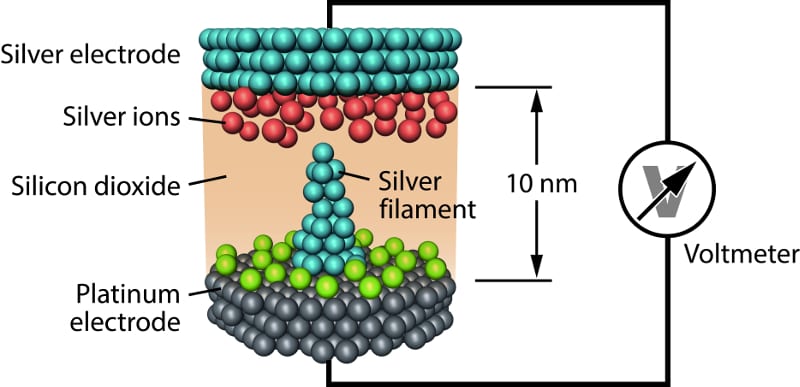
Configuration of a resistive storage cell (ReRAM): An electric voltage is built up between the two electrodes so that the storage cells can be regarded as tiny batteries. Filaments formed by deposits during operation may modify the battery’s properties. Image: Jülich Aachen Research Alliance (JARA).
Resistive memory cells (ReRAM) are regarded as a promising solution for future generations of computer memories. They will dramatically reduce the energy consumption of modern IT systems while significantly increasing their performance. Unlike the building blocks of conventional hard disk drives and memories, these novel memory cells are not purely passive components but must be regarded as tiny batteries. This has been demonstrated by researchers of Jülich Aachen Research Alliance (JARA), whose findings have now been published in Nature Communications. The new finding radically revises the current theory and opens up possibilities for further applications. The research group has already filed a patent application for their first idea on how to improve data readout with the aid of battery voltage.
Conventional data memory works on the basis of electrons that are moved around and stored. However, even by atomic standards, electrons are extremely small. It is very difficult to control them, for example by means of relatively thick insulator walls, so that information will not be lost over time. This does not only limit storage density, it also costs a great deal of energy. For this reason, researchers are working feverishly all over the world on nanoelectronic components that make use of ions, i.e. charged atoms, for storing data. Ions are some thousands of times heavier that electrons and are therefore much easier to ‘hold down’. In this way, the individual storage elements can almost be reduced to atomic dimensions, which enormously improves the storage density.
In resistive switching memory cells (ReRAMs), ions behave on the nanometre scale in a similar manner to a battery. The cells have two electrodes, for example made of silver and platinum, at which the ions dissolve and then precipitate again. This changes the electrical resistance, which can be exploited for data storage. Furthermore, the reduction and oxidation processes also have another effect. They generate electric voltage. ReRAM cells are therefore not purely passive systems – they are also active electrochemical components. Consequently, they can be regarded as tiny batteries whose properties provide the key to the correct modelling and development of future data storage.
In complex experiments, the scientists from Forschungszentrum Jülich and RWTH Aachen University determined the battery voltage of typical representatives of ReRAM cells and compared them with theoretical values. This comparison revealed other properties (such as ionic resistance) that were previously neither known nor accessible. “Looking back, the presence of a battery voltage in ReRAMs is self-evident. But during the nine-month review process of the paper now published we had to do a lot of persuading, since the battery voltage in ReRAM cells can have three different basic causes, and the assignment of the correct cause is anything but trivial,” says Dr. Ilia Valov, the electrochemist in Prof. Rainer Waser’s research group.
The new finding is of central significance, in particular, for the theoretical description of the memory components. To date, ReRAM cells have been described with the aid of the concept of memristors – a portmanteau word composed of “memory” and “resistor”. The theoretical concept of memristors can be traced back to Leon Chua in the 1970s. It was first applied to ReRAM cells by the IT company Hewlett-Packard in 2008. It aims at the permanent storage of information by changing the electrical resistance. The memristor theory leads to an important restriction. It is limited to passive components. “The demonstrated internal battery voltage of ReRAM elements clearly violates the mathematical construct of the memristor theory. This theory must be expanded to a whole new theory – to properly describe the ReRAM elements,” says Dr. Eike Linn, the specialist for circuit concepts in the group of authors. This also places the development of all micro- and nanoelectronic chips on a completely new footing.
“The new findings will help to solve a central puzzle of international ReRAM research,” says Prof. Rainer Waser, deputy spokesman of the collaborative research centre SFB 917 ‘Nanoswitches’ established in 2011. In recent years, these puzzling aspects include unexplained long-term drift phenomena or systematic parameter deviations, which had been attributed to fabrication methods. “In the light of this new knowledge, it is possible to specifically optimize the design of the ReRAM cells, and it may be possible to discover new ways of exploiting the cells’ battery voltage for completely new applications, which were previously beyond the reach of technical possibilities,” adds Waser, whose group has been collaborating for years with companies such as Intel and Samsung Electronics in the field of ReRAM elements.
Source: Jülich Forschungsszentrum

















